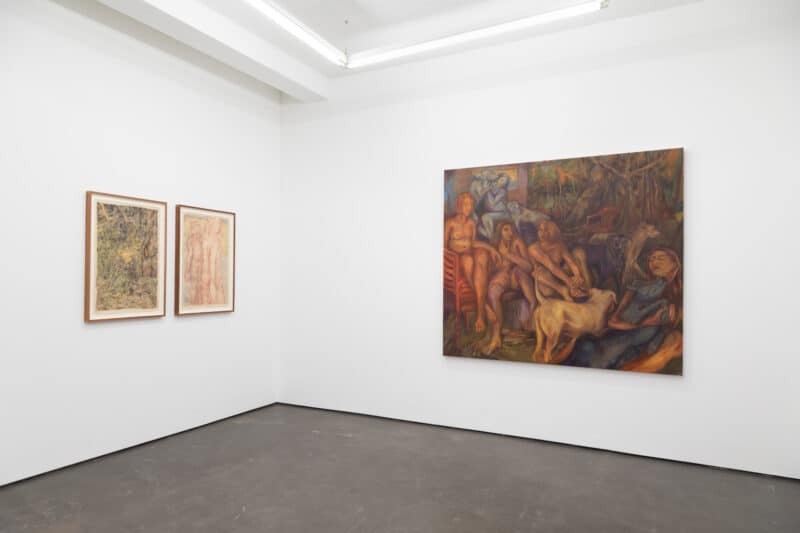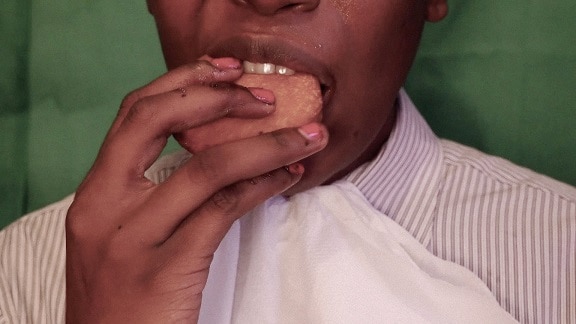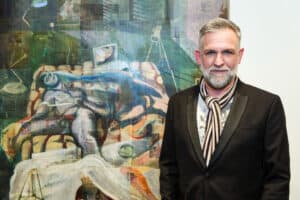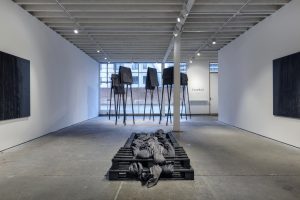Radical Residency is coming to its third edition, gathering together 10 new artists. Unit 1 Gallery | Workshop will be converted into a working studio till 31st March, hosting an international array of creatives. An exhibition, displaying the works made during the residency will open on the 5th of April.
 Hun Kyu Kim, ‘Regular Ordinary Artist Residency’, 2018, Traditional oriental pigment on silk, 120 x 90 cm
Hun Kyu Kim, ‘Regular Ordinary Artist Residency’, 2018, Traditional oriental pigment on silk, 120 x 90 cm
Unit 1 Gallery | Workshop supports a diverse range of emerging and mid-career contemporary artists. By providing them with space and time to develop their practice, it engenders ever innovative conversations. This year, Hun Kyu Kim’s pigmented silks will connect with Geraldine Honauer’s or Juliette Dominati’s sculptures, and Tobias Becker’s digital creations.
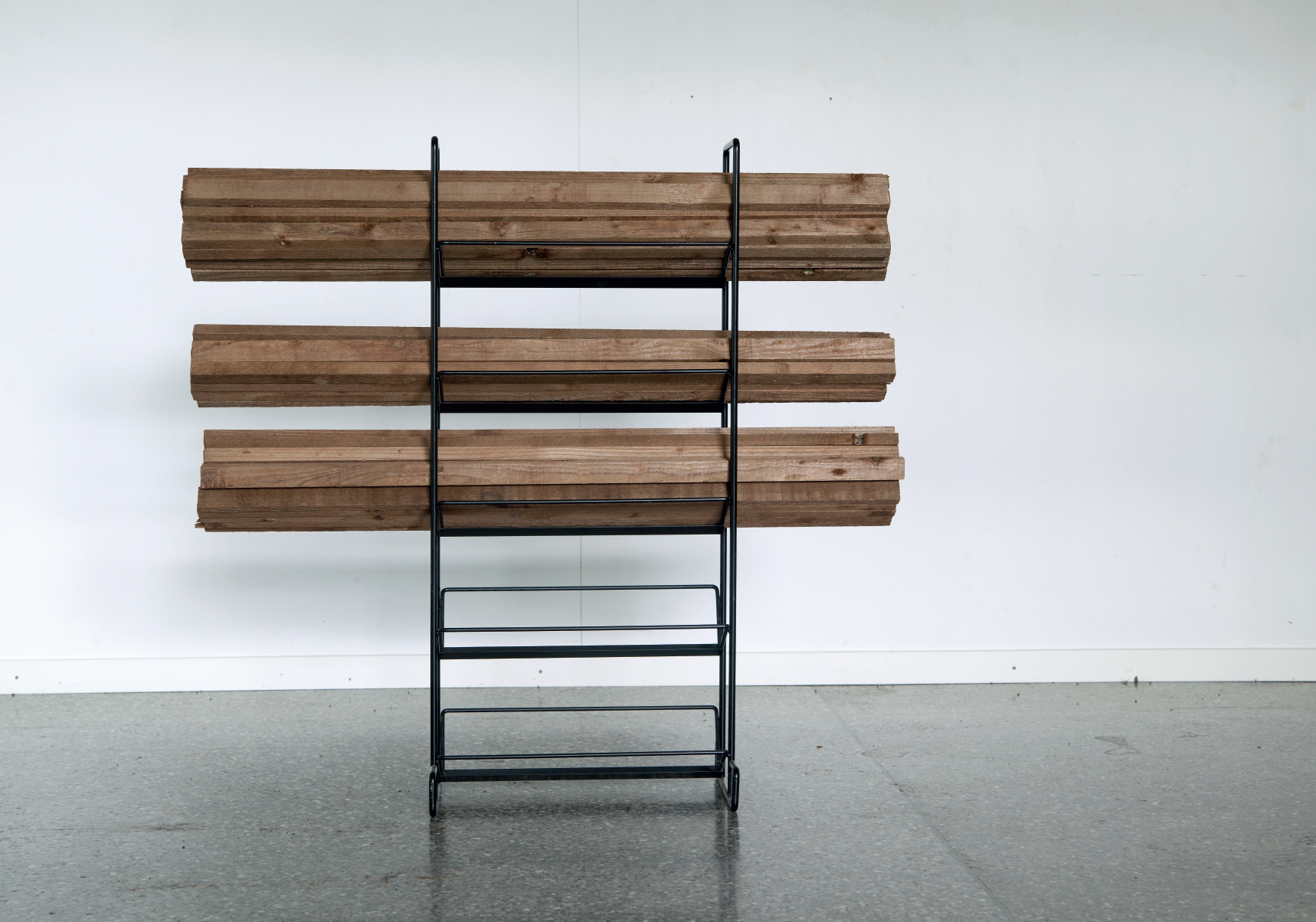 Geraldine Honauer, ‘Obstacle’, 2015, Wood and metal, 40 × 160 × 160 cm
Geraldine Honauer, ‘Obstacle’, 2015, Wood and metal, 40 × 160 × 160 cm
Unit 1 Gallery | Workshop, through the Radical Residency and following exhibition, gives artists, curators and theorists a platform to present work and share ideas. It also creates an environment for freethinking and exchange. From the replies the artists gave me regarding their feelings about sharing a space it seems as if excitement totally prevails over anxiety.
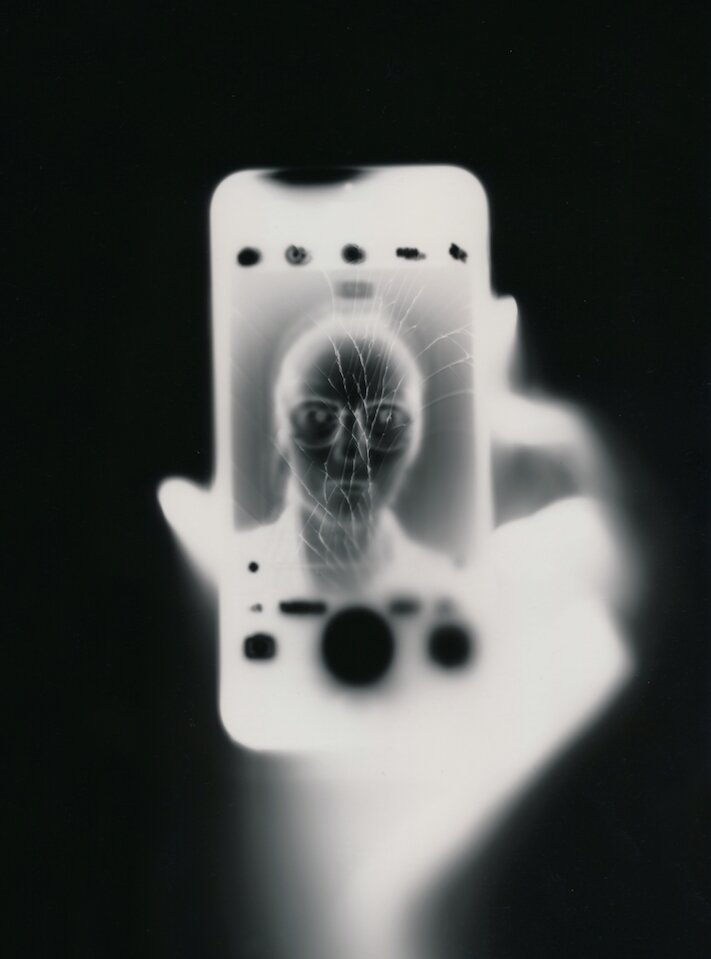 Tobias Becker, ‘Ilfospeed Selfies’ 2018, smartphone light on analog photographic paper, 18 x 24 cm
Tobias Becker, ‘Ilfospeed Selfies’ 2018, smartphone light on analog photographic paper, 18 x 24 cm
The exhibition length has been extended from 1 week to 3, building on the momentum of the previous editions. This third edition sees the participation of artists coming from five countries and working across a variety of media. The 10 lucky names are: Tobias Becker (Germany), Sam Carvosso (UK), Sooyoung Chung (South Korea), Juliette Dominati (France), Géraldine Honauer (Switzerland), Hun Kyu Kim (South Korea), Jean-Baptiste Lagadec (France), Henry Tyrrell (UK), Lucille Uhlrich (France) and Poppy Whatmore (UK). The Solo Studio Residency, with artist Ubada Muti, will be running in tandem upstairs.
 Juliette Dominati, ‘The donkey, the man and the house’, 120 x 240 cm
Juliette Dominati, ‘The donkey, the man and the house’, 120 x 240 cm
With issues around the ever-mounting costs of studio space in London coming increasingly to the fore, this initiative is particularly interesting. Not only it alleviates commercial constraints, but it also offers the additional enrichment of dialogue and exchange. The normally hushed gallery space is converted into a thriving hub where provocation and conversation become a daily creative force. The individual artists can respond to this multiplicity of stimuli, exchanging ideas and exploring themselves and their practices.
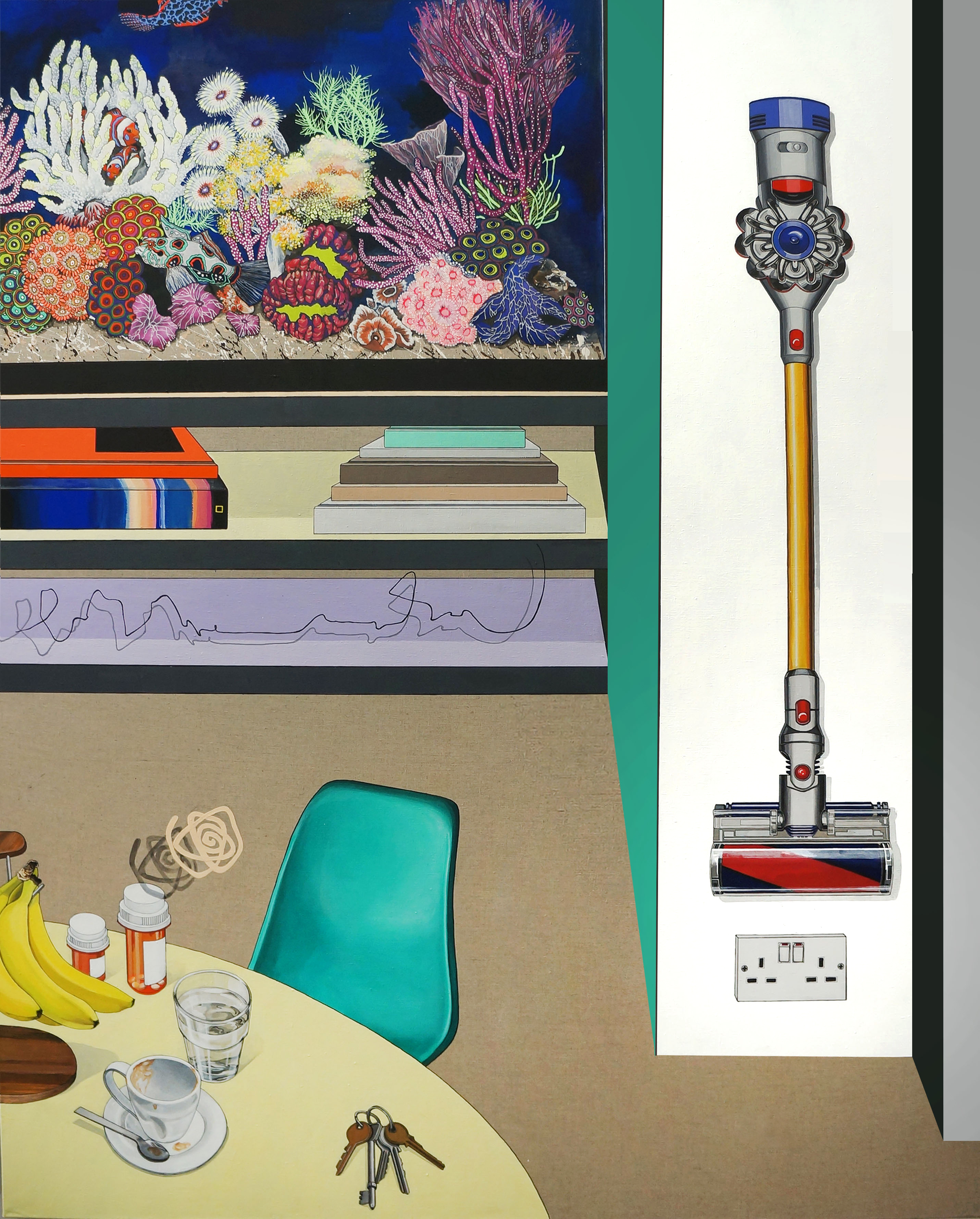 Sooyoung Chung, The Other Space Confirmed Bachelor, 2018, acrylic on linen
Sooyoung Chung, The Other Space Confirmed Bachelor, 2018, acrylic on linen
After watching the success of the first two editions, Unit 1 Gallery | Workshop founder and director Stacie McCormick states that
there are so many benefits to the artists working together in such an intense way, but the one that I did not anticipate, that seems to be the strongest, is the mutual respect and support.
Artists as well seem to share the director’s excitement and faith. I love how Tobias Becker thought of the shared studio as a beehive where everyone is working together and supporting each other to have one awesome, final product – the Radical Residency III exhibition.
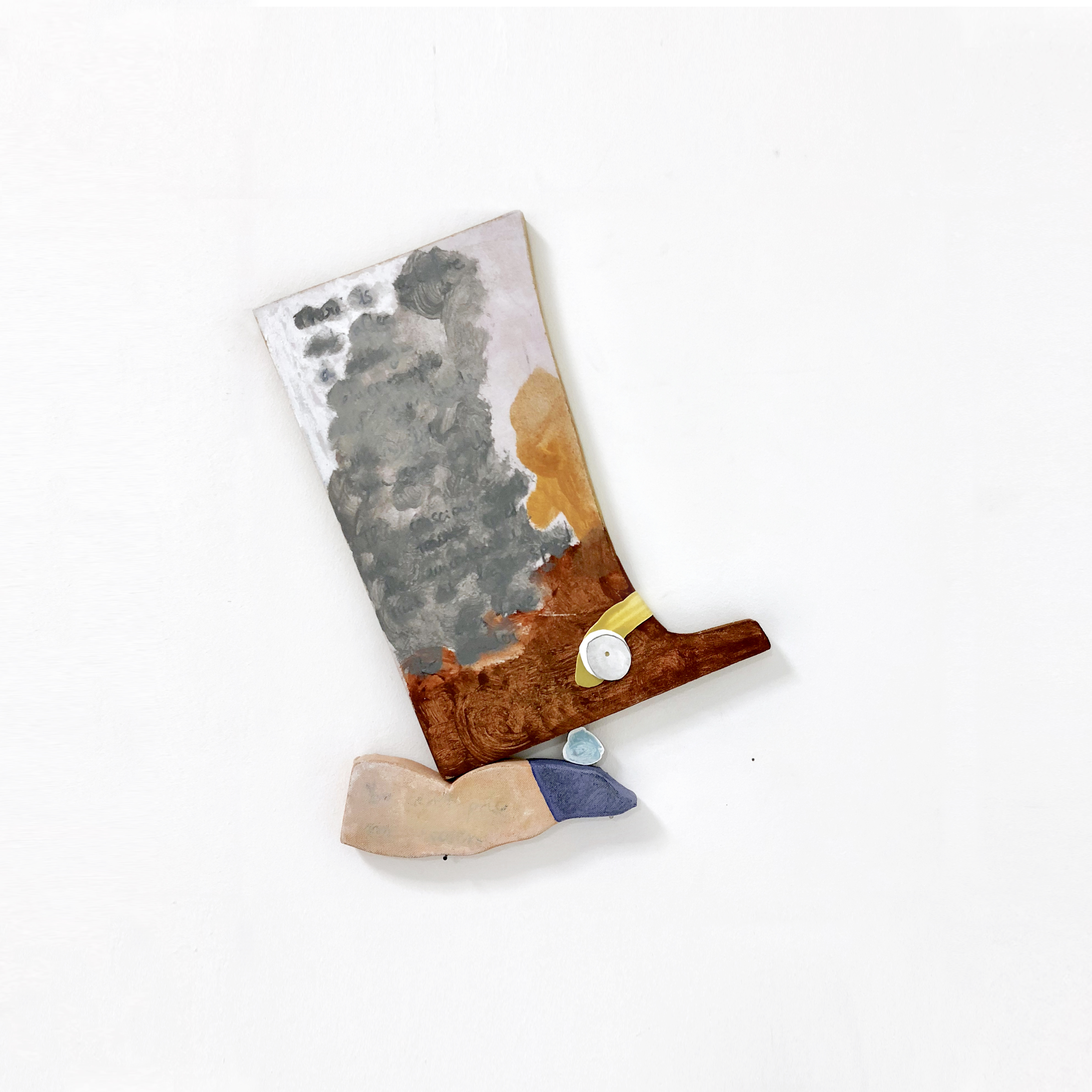 Lucille Uhlrich, ‘Shoed I Wander’, 2018, Mixed Media
Lucille Uhlrich, ‘Shoed I Wander’, 2018, Mixed Media
Everyone else generally expressed real enthusiasm for the opportunity of a barrier-free space where to work. The absence of physical walls and the encouraged encounter between different cultures, practices, and languages will definitely produce never-seen-before artworks.

Sam Carvosso, ‘As Real As It Gets’, 2017, courtesy of the artist and Unit 1 Gallery I Workshop
Read the rest of my interview with the 10 artists here:
What are your expectations for the programme?</strong
LUCILLE ULRICH: I hope I will do nice artworks and will meet lovely people from the art world.
JULIETTE DOMINATI: I expect to bond with new artists and new interlocutors while developing a new body of work.
POPPY WHATMORE: To create some new cohesive works in relation to my practice responding to both place and community.
TOBIAS BECKER: A big part of my working practice consists of research on hidden places, events and circumstances. I’m interested in points of collision, between the past and the future, but also of different knowledge and social contexts of individuals and communities; unpacking their complex relationship to the world and its surroundings. London, as a really diverse city where old and new go hand in hand with each other every day and ancient history and contemporary practice merge, is really interesting for me to work in and with. The studio space of Unit 1 Gallery | Workshop will serve me as a hub for the time of the residency. A place to take a break of the different impressions outside, but also a place to bring the different small pieces together and create a work that deeply copes with the surroundings of the gallery space. After visiting London a couple of times as a tourist, this time I don’t feel like one anymore. Here, you carry on with your regular life and art practice, just in a different location in the world. I’m expecting fluidity. Unit 1 Gallery | Workshop will sure help to support me in order to adapt to the new working environment and not to see it as an obstacle, but as a gift.
HENRY TYRELL: First and foremost I am looking forward to entering into a dialogue with others on the residency. This will be the first collective conversation I’ve participated in since I left college. I find that making work around other artists with their input can lead me to make surprising decisions. I also want to use the residency as an opportunity to experiment with processes that I don’t usually concentrate on. I have always tended to paint on canvas so I intend to use more disposable ready-to-hand materials like paper and cardboard through the residency. However because there is an exhibition at the end I can’t afford to get too lost in the experimentation! Also I am prepared to shift my aims a bit once I get going.
HUN KYU KIM: A proper space and enough time are essential for an individual artist to continuously focus on his or her artistic practice. Thus, I truly believe that the programme thankfully supports each artist in many ways. One of the most interesting things in this programme is the residency space. Unlike other residency programmes, there is no wall among the artists, allowing them to interact more freely, which is pretty impressive. Thus, I expect many positive synergy effects.
SOOYOUNG CHUNG: I expect the great synergy that arises from exchanging practices with other artists, and sharing a studio space with them.
SAM CARVOSSO: I’m hoping to make a new body of work reflecting on previous research on ‘campsite as studio’, and how it relates to the residency context. Within campsites you have limited materials to work with, and must carefully consider the tools you bring due to weight and space limitations. The same goes for the Radical Residency programme. Above all else, I expect my time to be challenging and rewarding, and thoroughly enjoyable with my fellow residents.
JEAN-BAPTISTE LAGADEC: I’m currently without a studio, so I’m really happy to be able to work on a big scale in such a pleasant environment. I had my materials at home for a while, and was really looking forward to getting going!
GÉRALDINE HONAUER: I always try to keep my expectations out of my mind. I’m enjoying the time and space for exchanging ideas, points of view and experiences with the other artists from all over the world who are part of the programme.
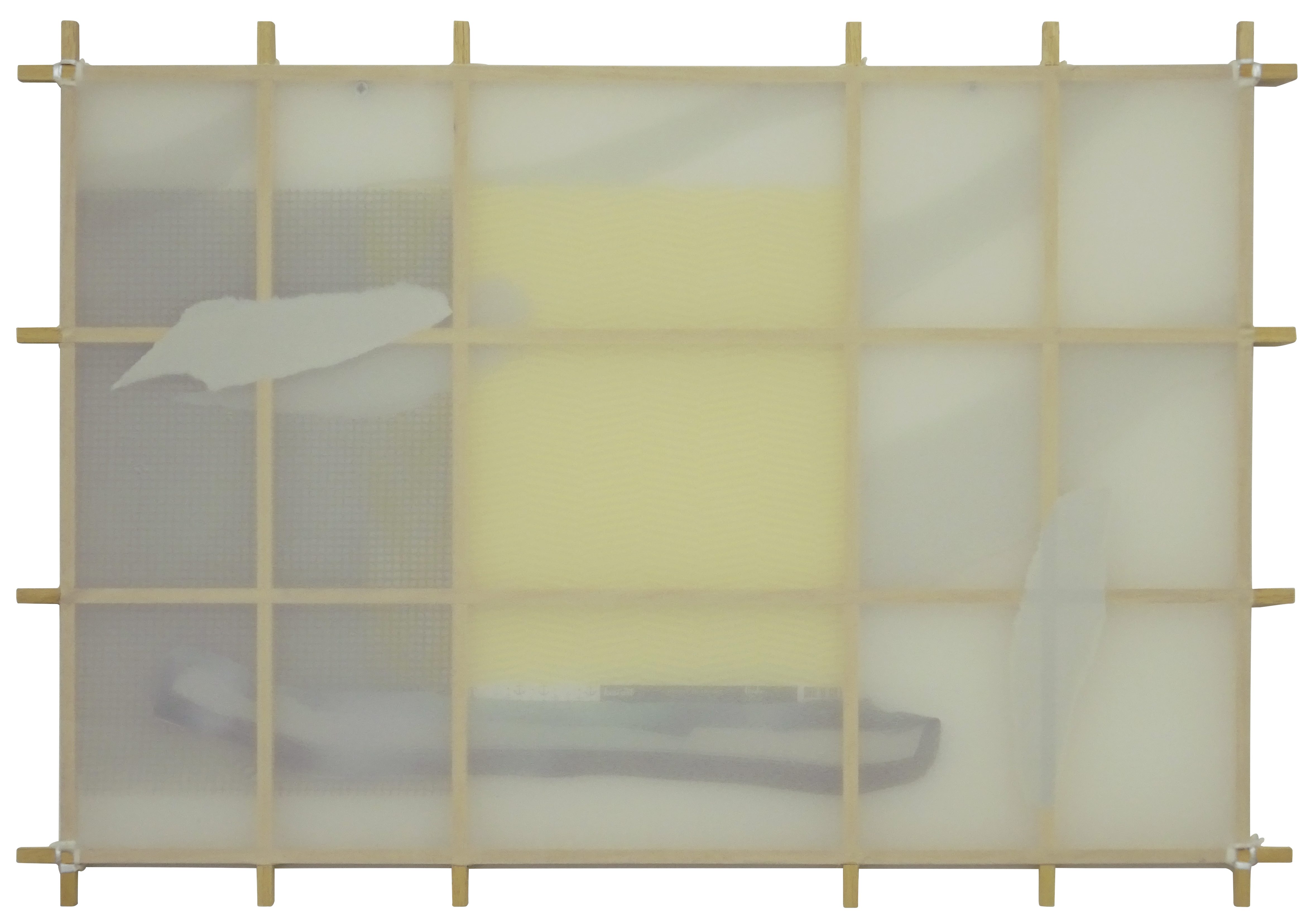
Jean-Baptiste Lagadec, ‘Untitled (Structure study)’, 2017, 60 x 40 cm, wood, string, fabric, grid, paper, acrylic
How do you feel about sharing a space with many artists you do not know?
ULRICH: It’s exciting!
DOMINATI: Today was the first day. Just seeing how everyone taped his/her plastic sheets to cover the ground and marking his/her space was nice. Everyone had his/her own techniques, doubts, manners and approach.
WHATMORE: I’m excited to share a space with other artists. The experience is intriguing and I am learning new methods and materials through the process.
BECKER: The residency brings together 10 artists with 10 different backgrounds and 10 different working practices. Working together in one big studio space means a lot of communication and influencebetween each other. I’m expecting an exchange of knowledge. Coming from Germany and not really knowing the city and its diverse culture brings a lot of potential, but also leaves me with the question of where to start at first. Talking to the residents already familiar with London gives me foresight I otherwise would not have. Coming from an outsiders perspective, you are directly being thrown inside the art world of London, but also the culture of the city. Inside the studio space, it will be a constant reassurance and weighing of different ideas and approaches. The studio situation reminds me of the first year in my German art school, the Kunsthochschule Mainz. Beginning there means also beginning in the base class, sharing one big room with about 20 other art students who help and support each other, share materials and thoughts. When getting stuck with your ideas, it is very helpful to talk to someone inthe same boat and to let your idea also flow through other brains. I don’t see the combined working space as a challenge, more as a beehive where everyone is working together and supporting each other to have one awesome, final product – the Radical Residency III exhibition.
TYRELL: I’m excited about sharing the space with 9 other artists as it’s been a while since I shared a studio spacewith other people. I think the challenge to this is trying not to be self-conscious so that you avoid taking risks with the work. However I think it is actually quite useful to get over this hurdle.
KYU KIM: I am pretty familiar with sharing a space with other artists whom I don’t know completely. It seems pretty nerve-wracking at first, but meeting new people who are totally different from my background mostly makes me feel excited because that means I’ve met many artists from whom I can learn a lot. Frankly speaking, I hope there are a few eccentrics amongst the group who can inspire me in a positive way!
CHUNG: If we respect each other’s space, sharing the studio will have a very positive effect. Each of the artists’ practices involves a very different approach; so the artists can create new experiences in their own work by understanding that of the others’.
CARVOSSO: I think it’s great. An arts community is crucial to the development of an arts practice. New eyes, new thoughts, new discussions.
LAGADEC: It’s rather nice! The artist life can get a bit lonely sometimes, it’s great to be part of such a nice group. It seems we are setting a good dynamic. I work even harder when I am surrounded by hard-working people.
HONAUER: I feel this is an intense time with a lot of possibilities. I love the concept of sharing, it’s an important part of our society and also part of my work – I try to use things and moments in between for a certain time, this is my subject.
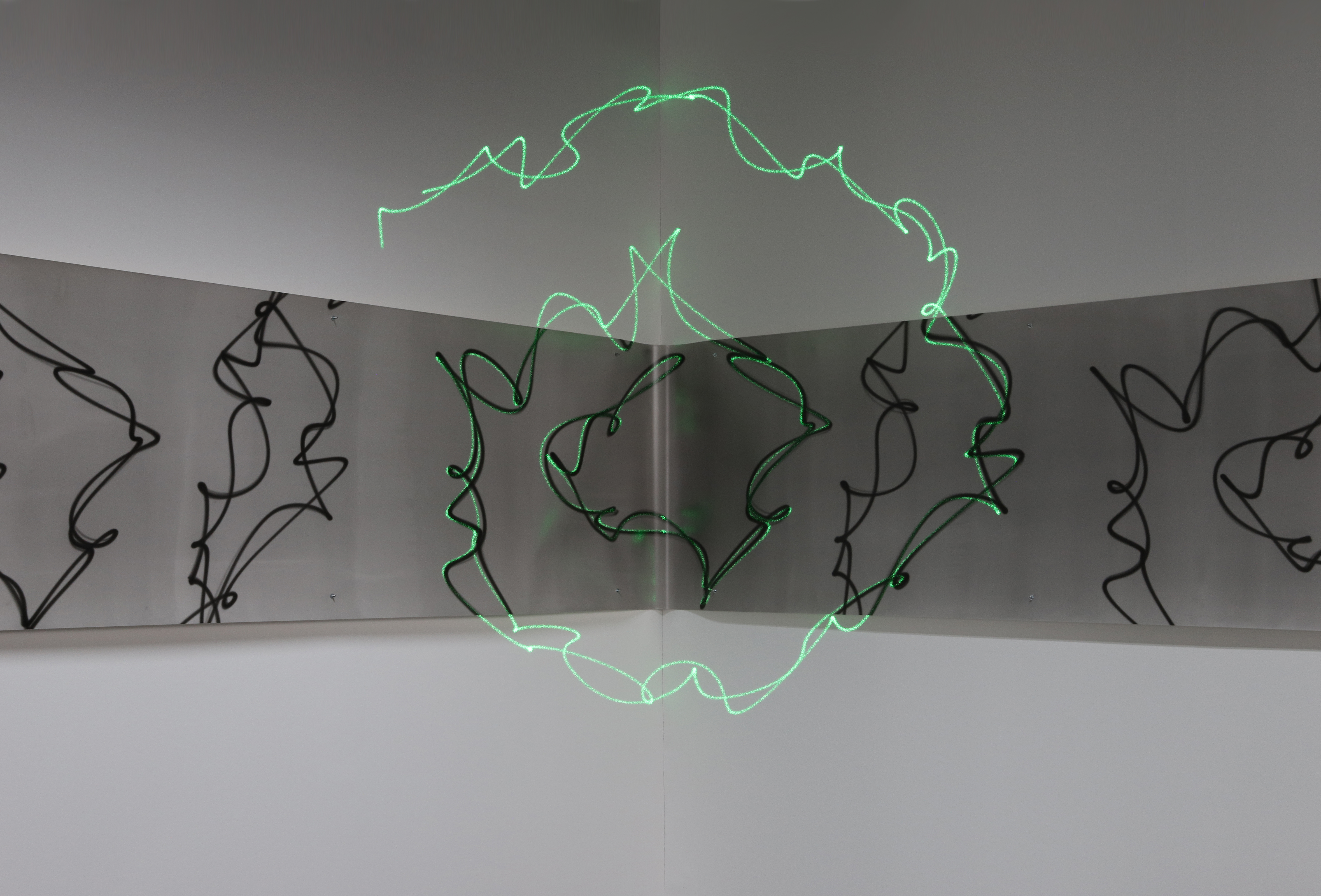
Tobias Becker, ‘A Static Peak’, 2018, laserbeams on analog photographic paper, 800 x 70 cm
What do you hope to achieve by working alongside other artists who may have a completely different approach to art than your own?
ULRICH: I prefer to work with people with a different approach, it doesn’t really affect me
DOMINATI: It’s always a challenge to understand someone else’s research. Its takes time and engagement. Sharing a studio for one month with 9 other artists means working alongside them, seeing the work developing and seeing the choices the artists make at each step of their process. It is a great opportunity to enter into another’s logic.
WHATMORE: It is interesting to hear about other artists’ diverse practices and approaches to work. All the artists have different rhythms of working and thought processes. All the artists are from different countries so it is an opportunity to learn about different cultures too.
BECKER: This is actually a very good coincidence. In art school, everyone develops their special working practice and becomes a specialist in their field of choice. I think after specialising on something it is hard to go back to a 360-degree view, having in mind all techniques and possibilities. The studio here acts as a kind of laboratory with different specialists researching projects. Working here means seeing more possibilities than you would normally see by yourself I think.
TYRELL: I think that people who have very different practices are often the best people to talk to as they have surprising insights and make surprising connections with the work. Also because I am planning to do a lot of work on paper over the course of the residency I am hoping to pick people’s brains about technical issues to do with the stretching of paper as well as display solutions for this kind of work. As many of the artists for this residency are coming from different countries it will be great to discuss our experiences working in different cities.
KYU KIM: It is commonly believed that people can learn who they really are through the existence of other beings. Thus counter interaction – which plays a pivotal role in forming an image of self – is definitely essential for an individual artist so they can reflect themselves through the interesting collision. Considering the fact above, the programme will be very fruitful for each artist, broadening their perspectives in a continuous manner.
CHUNG: The same as I stated before.
CARVOSSO: It’s important to have different artists around you as we all learn from and influence one another. I have a background in sculpture but I’m looking forward to being with artists of all disciplines.
LAGADEC: Not much, other than my own goals! I will certainly feed off their positive energy, hard work, and humour. Working alongside other artists is also a nice opportunity to assess my own efficiency. It’s a luxury to see anyone at work; how they move, how they start, when they stop, which part of the process they skip, which part they focus on… it’s their practical approach that I learn from.
HONAUER: I think understanding a different approach is an important opportunity to train yourself to have a more open mind, and also to inspire your own work by leaving the comfort zone.

Jean-Baptiste Lagadec, ‘Pond (Ariane VI)’, 2017, 160×114 cm, acrylic and ink on wood
How do you think this experience will integrate into your practice?
ULRICH: I think I will adore the new people, and that the experience will change my schedule and thus change my work a little.
DOMINATI: I usually glean many objects and materials, and start many pieces at the same time.
For once, I would like to not get too multi-directional (or messy!) and develop 1 or 2 pieces. Having a one month deadline will make me focus on a final object.
WHATMORE: It is interesting to work in a space that you will exhibit in too, as it allows more time to be familiar with the space and the work of other artists. It is possible that some of the works will respond to each other.
BECKER: Having the final exhibition in mind also means looking at how it all fits together in the end. This naturally brings you to a process of adaption I think. The problem of fitting it all together then suddenly turns into an advantage, breaking out of your regular style of presentation and formal design of your work.
TYRELL: I am hoping that this period of experimentation will cultivate a more propositional, unfinished and experimental aesthetic that could end up informing the way that I approach the painting process. Also during the residency, I aim to radically reduce my use of colour in my work. Through the imposition of limitations often come discoveries and I am hoping that this process will inform my wider work.
KYU KIM: I like the name of this programme, Radical Residency. It is generally said that the radical mind looks a little bit dangerous and unstable, but it can also be considered as an enthusiastic and energetic mind that might be able to make a small wave that goes further and further outwards, making a big circle. Just like making the small wave, sharing those ideas from many artists who are totally different from my background seems like a form of civic awareness and public engagement, which are crucial keywords of my art world.
CHUNG: Personally, as a painter, I am visually influenced by colours, lines, and also surfaces that are seen around me. All the artists in the Radical Residency have different visual languages, so they will have various effects on my painting. It’s a very different experience from the inspiration I get from a particular exhibition, and I think it will have a small impact every day on my painting.
CARVOSSO: Being outside of my studio and in a new context will definitely affect my practice. As previously mentioned, I’m interested in how camping relates to the residency experience – pitching up your space, limited tools, working with new surroundings, etc. I’m looking forward to how my work develops from this.
LAGADEC: It will! I hope a lot of other good things come out of this.
HONAUER: This experience is an extension of my existing way of working, and so another possibility to move out of my space; from space to space I see a new possibility to expand my work.
 Sooyoung Chung, ‘Biographical Object no.61’, 2018, acrylic on linen
Sooyoung Chung, ‘Biographical Object no.61’, 2018, acrylic on linen
Do you have any fears about the project?
ULRICH: No!
DOMINATI: My work is a lot about improvisation, it has its share of fear. I find adrenaline as a motor of painting. I never quite know what forms will emerge and catch. I will spend a few days walking and taking videos before knowing what to do. Of course, it will involve painting, colours, shapes, and constructing a space that has its own logic.
WHATMORE: Obviously, not sure what I will exhibit, always a primary fear as an artist.
BECKER: No.
TYRELL: My only fear is that I might get lost in the process of experimentation with the exhibition approaching fast. Even though a month is a long time- making work that you are happy with is easier said than done! All in all I think that this residency is a really good idea. It gives us use of a fantastic space and the opportunity to meet and start a dialogue with a great group of artists.
KYU KIM: Nothing!
CHUNG: No, I am really excited about it. 🙂
CARVOSSO: Having one month to produce new work for a show can feel a bit daunting, but I believe it’s all a part of the challenge of making work in a new context.
LAGADEC: At first I did! My set up wasn’t quite right and I was terrified of spilling my paints everywhere. But I think it’s fine now. So it’s all good.
HONAUER: No, I don’t.
From these responses, I am already curious to see how these artists’ practice will develop. I cannot wait to see the exhibition, discovering the impact left by the interaction between distant vocabularies. The ‘no-fear’ declaration of so many of the participants, and their eagerness to be touched, disturbed, inspired by various artistic personalities is extremely promising and engaging!
Radical Residency III Unit 1 Gallery | Workshop
Working studio dates: 4 – 31 March 2019 Exhibition dates: 5 – 25 April 2019 Private View: 4 April, 6-9pm
1 Bard Road, London, W10 6TP


